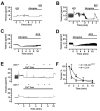Myosin light chain kinase is central to smooth muscle contraction and required for gastrointestinal motility in mice
- PMID: 18586037
- PMCID: PMC2648853
- DOI: 10.1053/j.gastro.2008.05.032
Myosin light chain kinase is central to smooth muscle contraction and required for gastrointestinal motility in mice
Abstract
Background & aims: Smooth muscle is essential for maintaining homeostasis for many body functions and provides adaptive responses to stresses imposed by pathologic disorders. Identified cell signaling networks have defined many potential mechanisms for initiating smooth muscle contraction with or without myosin regulatory light chain (RLC) phosphorylation by myosin light chain kinase (MLCK). We generated tamoxifen-inducible and smooth muscle-specific MLCK knockout (KO) mice and provide direct loss-of-function evidence that shows the primary importance of MLCK in phasic smooth muscle contractions.
Methods: We used the Cre-loxP system to establish Mlck floxed mice in which exons 23, 24, and 25 were flanked by 2 loxP sites. Smooth muscle-specific MLCK KO mice were generated by crossing Mlck floxed mice with SM-CreER(T2) (ki) mice followed by tamoxifen treatment. The phenotype was assessed by histologic, biochemical, molecular, cell biological, and physiologic analyses.
Results: Targeted deletion of MLCK in adult mouse smooth muscle resulted in severe gut dysmotility characterized by weak peristalsis, dilation of the digestive tract, and reduction of feces excretion and food intake. There was also abnormal urinary bladder function and lower blood pressure. Isolated muscles showed a loss of RLC phosphorylation and force development induced by K(+)-depolarization. The kinase knockout also markedly reduced RLC phosphorylation and force development with acetylcholine which activates Ca(2+)-sensitizing signaling pathways.
Conclusions: MLCK and its phosphorylation of RLC are required physiologically for smooth muscle contraction and are essential for normal gastrointestinal motility.
Conflict of interest statement
Conflicts of interest: There are no conflicts of interest to disclose.
Figures








References
-
- Kamm KE, Stull JT. Dedicated myosin light chain kinases with diverse cellular functions. J Biol Chem. 2001;276:4527–4530. - PubMed
-
- Somlyo AP, Somlyo AV. Ca2+-sensitivity of smooth and non-muscle myosin II: modulation by G Proteins, kinases and myosin phosphatase. Physiological Rev. 2003;83:1325–1358. - PubMed
-
- Murthy KE. Signaling for contraction and relaxation in smooth muscle of the gut. Annu Rev Physiol. 2006;68:11.1–11.30. - PubMed
-
- Ito M, Nakano T, Erdödi F, et al. Myosin phosphatase: structure, regulation and function. Mol Cell Biochem. 2004;259:197–209. - PubMed
-
- Somlyo AP, Somlyo AV. Signal transduction and regulation in smooth muscle. Nature. 1994;372:231–236. - PubMed
Publication types
MeSH terms
Substances
Grants and funding
LinkOut - more resources
Full Text Sources
Molecular Biology Databases
Research Materials
Miscellaneous

